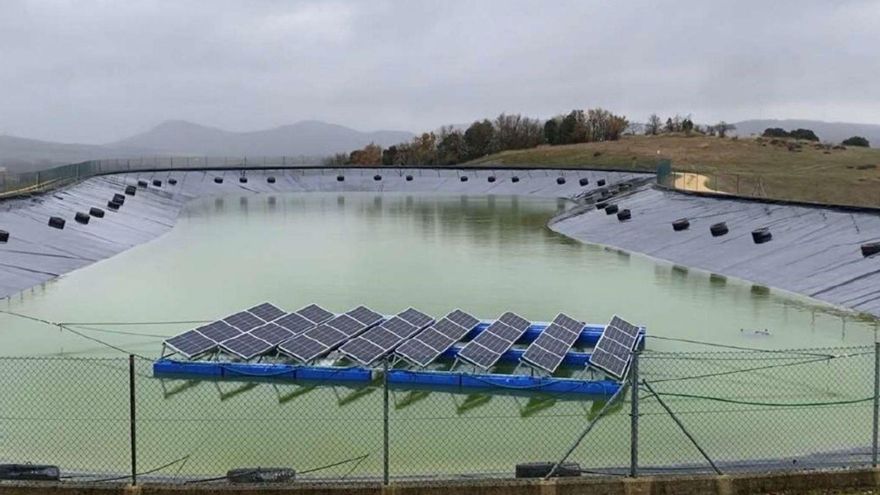
The brutal rise in the electricity tariff or the fear of fuel supply difficulties due to Russian invasion of Ukraine These are the factors that have led the local administrations of Tenerife to shield themselves against energy surcharges. Contingency plans, savings policies or promotion of renewable energy projects are some of the proposals. ANDhe Cabildo and the eight main municipalities are entrenched to fight against dependence on the ups and downs of the market.
The Cabildo affects the commitment to photovoltaic energy in Balsas de Tenerife (Balten) as the main planned saving measure. The insular institution will invest 3.5 million in the field of irrigation and in two lines of action to supply the extra energy costs. The island councilor for the primary sector, Javier Parrilla, explains that “since the end of 2020, Balten has focused on promoting a sustainable energy strategy in infrastructures.” As the main axis, adds Parrilla, “we are committed to decarbonization, with green infrastructures in the transit of fossil energies to a clean energy system.”
Eight actions form the first phase this year with the installation of photovoltaic solar panels –including the San Antonio pond, in La Matanza– for 1.5 million that will generate 4,100 MW/hour/year (4,100,000 kW/h/year). The action, at today’s (yesterday’s) average price of the electricity rate “would pay for itself in a year.” Concludes Parrilla: “These actions will mark the future in the short, medium and long term to provide greater energy independence.” Balten will provide an additional two million to balance the energy cost overruns and prevent them from falling on the irrigators.
Santa Cruz (204,856 inhabitants)
The capital of Tenerife has calculated the variation in spending on the most important consumptions. Thus, in general electricity, the comparison of the cost between 2021 and 2022 goes from 2,658,177 euros to the forecast of 4,320,479 (the rate has been multiplied by three). The total increase in energy consumption (Power Term and Energy Term) is 62.5% and the increase in Energy Term alone reaches no less than 96.6%.
The cost of electricity has a direct impact on the integral water cycle. In the last year it has increased more than 300%. The one consumed in the integral water cycle will go from 3.6 million in 2021, to 12.5. Only in electricity, more than 9 million will be spent for excess (350%) of which, the increase in desalination cost will be about five million. (from 3.5 to 8.5).
On the other hand, 72% of Emmasa’s electricity consumption is produced in the desalination plant. Santa Cruz is the only municipality on the Island that depends directly on its own desalination plant. Electricity is used to produce desalinated water, but also in pumping to elevated tanks, in wastewater collection and in its treatment. 60% of the water consumed comes from the desalination plant, which reduces extraction in wells and galleries and, with it, environmental effects. The central government, through the Canarian Executive, has been subsidizing desalination for years. Santa Cruz receives 750,000 euros a year, 21% of the 3.5 million total cost. This year desalination will cost 8.5 million and the capital will again receive 750,000, 9% which “is insufficient.” The extra cost will be borne by the municipality.
The City Council of the capital studies measures before the increase in the cost of electricity calculated at 1.3 million, 30% more. This week the mayor, José Manuel Bermúdez, warned that they should be “prudent” and make decisions in preparing the budget.
The Lagoon (153,655 inhabitants)
The Lagoon Town Hall benefits from an agreement of the Spanish Federation of Municipalities and Provinces that translates into a regulation of the rate. A limited fee for the service, modernized through the deployment of LED technology by Aguere. In just two years (2020 and 2021), the successful public lighting company (Effico) replaced 3,120 luminaires with annual savings of 640,000 kilowatt hours per year; or 104,000 euros on the bill.
Crown (78,930)
The Aronero City Council has an energy contract that does not depend on market fluctuations. The fixed price only changes when state regulations do. This increase does not now have a direct impact. A study for the installation of photovoltaic energy throughout the municipality has already begun. New projects already include it on a mandatory basis.
Adeje (47,869)
Energy consumption has three fundamental axes: public lighting, service buildings and water treatment or purification plants. In all of them, a saving work is done as a result of the commitment to the energy transition in the Adeje City Council. The greatest expense is given by the treatment plants, but “it is necessary to guarantee the supply.” Regarding lighting, LED luminaires have led to savings of 30% or 40%. In public buildings the policy is to reduce costs by using energy only when necessary.
Granadilla de Abona (46,816)
The Consistory of Granada has a contingency item to deal with the payment of electricity bills. In addition, it has already drawn up the Action Plan for Climate and Sustainable Energy (PACES), with the commitment to reduce C02 emissions and install photovoltaic panels. An energy audit has also been carried out for the placement of LED luminaires.
Orotava (41,500)
The Orotavense City Council is studying economic and legal alternatives, although the city council does not process billing directly but through the public lighting concessionaire.
The Realejos (36,218)
The Realejero City Council has signed a contract with Naturgy based on the agreement of the Spanish Federation of Municipalities. The current invoicing of the supply is made with prices in the wholesale market of the third quarter of 2021. It does not affect yet, but it will affect.
Puerto de la Cruz (29,947)
The municipality of Porto endorses a study for the installation of the first centralized heating and cooling network supplied with geothermal energy in the Canary Islands. It also promotes a plan for the installation of photovoltaic panels in public buildings.
Brussels must make a move to lower the market price
The brutal rise in the price of electricity adds pressure for Brussels to take drastic measures to avoid an escalation of natural gas that stresses continental electricity markets to the extreme. With no changes of significance, Europe is sailing on a collision course, doomed to an inflationary spiral with unforeseeable consequences. The Spanish Government has confirmed that it is working on a new battery of measures to alleviate the impact on consumers but that they will wait to see the proposal for changes from Brussels to make them public. In both cases the delay worsens the picture every day. The invasion of Ukraine by Russia – the second largest producer of natural gas in the world and the first European supplier – has been the trigger for the explosion of the electricity bill. The anomaly came from before: in July of last year the threshold of 100 euros per megawatt (MWh) was exceeded for the first time, in October the 300 were left behind; in December, the 350; this past Monday, the 400 and on Tuesday, the 500. This new rise has a direct impact on more than one in three households and SMEs, which have a regulated rate or PVPC (voluntary price for small consumers). The rest will suffer later, as they have to renew. Gas, which first rose due to the brutal post-pandemic rebound in Asian demand and is now doing so in the wake of Moscow’s military offensive, has been the determining factor in the escalation. Each euro of rise in the Dutch TTF market – the European reference – translates into a rise of around two euros in the regulated electricity bill. Europe is considering extending the sanctions to the energy sector as well, but the escalation seems to have no end. | jdm
















